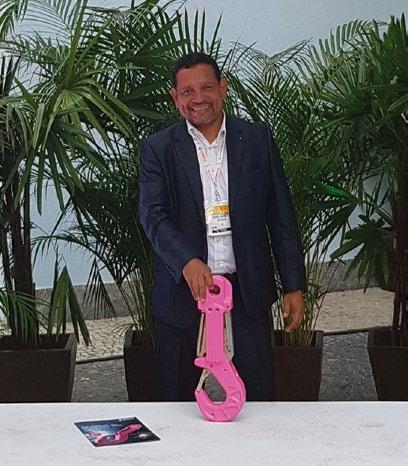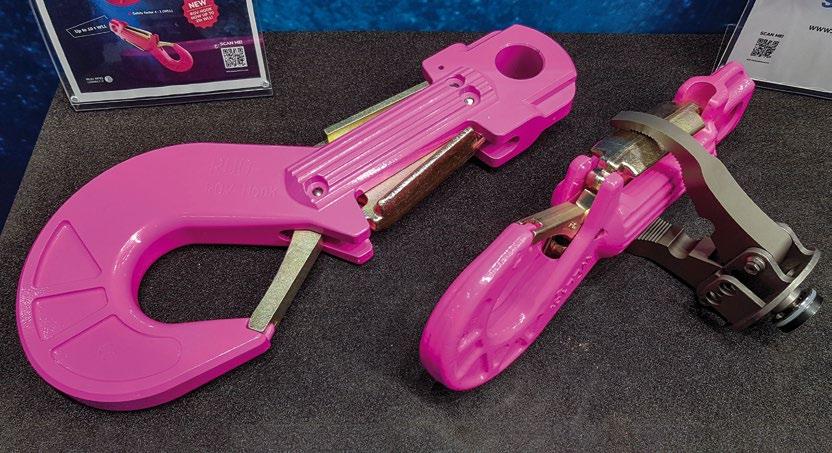
9 minute read
Interview: RUD ROV Hook – Subsea Lifting to the Next Level
RICHIE ENZMANN: David, In our previous edition we reported about our impressions at QSTAR’s in Barcelona using the newest ROV Hook developed by RUD. You have been at the forefront of development of this game-changing product from the beginning, tell us how all this started and why.
DAVID JARAMILLO: Well, as in every good product develop ment process, it started with a customer’s request, back to early 2014. One of our customers in the marine sector, Sub sea7, approached us, requesting a solution for their rigging issues resulting from the use of conventional ROV-assisted hooks. A long-existing problem, well documented by IMCA and HSE i.a. and which so far no manufacturer was willing to approach. At that time I was quite new at RUD, defining
Advertisement

Courtesy of RUD
new strategies for the Marine & Offshore sector and imme diately I identified an ideal opportunity, despite the relative small market volume for this particular piece of hardware, to evidence the immense potential and strength of RUD in being innovative. Thus, yes, we took the challenge.
R.E.: Which were those “issues”?
D.J.: Basically, there were two major safety issues to be solved. However, many other important challenges ap peared in between as well. Firstly, the so-called “shedding” was a big concern. This means the loss of loads as a result of unintentional opening of the hooks. Secondly, the “snag ging” or accidental rigging due to protruding parts, such as an enlarged tip of the hook’s nose and also the very com monly used “monkey fist” attached to the hooks for operation. Both issues pose major operational safety risks when working in deep waters, remotely manipulating sophisti cated and expensive equipment in short time windows and due to the extremely challenging operational environment.
R.E.: And how was it solved?
D.J.: Based on the specified requirements we had to design a complete new type of hook. Putting aside most concepts found in the traditional designs. The outwards opening latch was a key element in preventing shedding, the overall smooth shape aimed at solving the snagging issues.
R.E.: Which were the main challenges?
D.J.: From the beginning, beside operational safety, we based our concept on “ease and speed of use”. We knew this was crucial for the success of the product. Then, at the end of the day the reduced operational time incrementally turns into visible monetary savings for the operators and contractors. The reliability and robustness of the hook played also an essential part in our development objectives.
Courtesy of RUD
interesting and intensive process, with new aspects and refinements and enhancements at the end. There are thus,
The other side is the manufacturing perspective. We needed a product that could be produced in a feasible way, and to be accessible to a reasonable price in the market.
R.E.: What was wrong with conventional ROV Hooks?
D.J.: looking at conventional ROV-assisted hooks, we realised that the problems often occur because these hooks were basically adaptations of hooks used in topside, mostly onshore applications. Here we speak basically about two types of hooks: the snap hook and the self-locking style The rounded shape with ripples of the trigging area and the optimised for a maximum gripping effect in interaction
hooks, which are respectively equipped with a lanyard or wired extension for ROV operability. None of the avail able designs was specifically developed for subsea use and therefore did not take all relevant operational conditions into consideration.
R.E.: What is the novelty of the RUD ROV Hook?
D.J.: To start, a one-hand operation for both attaching and releasing of loads was an important requirement, therefore the opening/closing mechanism needed to be completely re-engineered. On top of that, a reliable locking mechanism was in the focus of the development efforts. Here is where the trigger concept comes into scene; pressing the trigger opens the hooks, releasing the trigger automatically closes the opening/closing/locking mechanism builds up the nov elty and uniqueness of this design.
R.E.: How long did it take to develop this solution?
D.J.: The project started officially in spring 2015 and it took us something more than two years to finalise the design and come up with a satisfying solution for our customer and developing partner Subsea7. In this period we designed and extensively tested in the field, under operational con ditions, four different prototypes and variants. It was an requirements appearing each round, and with adjustments, many design details that make this ROV hook a unique so lution with quite interesting and value-adding features.


R.E.: Can you give us an example?
D.J.: The reliability of the hook starts in the approaching phase. In this situation the first contact is quite crucial for a speedy operation. Ideally gripping the hook correctly should work at once, right away, with whatever type of manipulator, three or four fingers, intermeshed or parallel. curved form of the trigger’s contact surface are therefore and, most importantly, locks the hook. So we can say that
with the ROV, even at inclined approaching angles, up to 30° from the ideal approaching position. This, in combi nation with the innovative locking mechanism, makes the hook unbeatable in terms of “speed and ease of use”. At that time some users categorised this as “disrupting tech nology” other called it a “revolution”. That’s how the latter became part of our initial promotional slogan.
R.E.: Do the ROV pilots require additional skills for operat ing this hook?
D.J.: The human factor plays always an important role. The ease of use of this ROV hook makes it however simple also for say “less skilled” ROV Pilots or trainees to manipulate loads. We know that most users out there are used to the “wired solutions”, just because there was no other option
Courtesy of RUD

before. With our solution this has now changed and ac cording to the feedback we have received so far, once the ROV Pilots understand and experience themselves the ad vantages of the new approach they rapidly get used to it and it becomes they preferred way of working.
R.E.: Meanwhile there is new twin-trigger version of the Hook, why?

D.J.: Just after the first users started using the new hook the enthusiasm was so big, that few of them started doing things with the hook, for which it was initially not designed. For example turning and positioning loads under water. Basically, using the hook as a shackle connection while turning the hook upside down and things like that. We rap idly acknowledged that a “secondary locking system” had become an unforeseen requirement to cope with these situations as well. So we started thinking about it, within the process of normal user-driven product evolution. The result of this is the new twin trigger mechanism, which we have successfully launched in September 2019 at the Off shore Europe Show in Aberdeen.
R.E.: Could you explain a little bit more about it?
D.J.: It is a basically a two-stage securing of the hook open ing/closing mechanism that works by means of two triggers that are engaged together. Only when pressing both triggers simultaneously -something that will never acci dentally happen- the hook would ever open. This is what we have called “ultimate safety”. And yes, now the hook can even be deployed for connections, where shackles are typically used, e.g. turning and positioning of loads, pro viding a wider scope of uses in subsea, but also in topside applications. R.E.: And now there is also a bigger version than 10t WLL?
D.J.: Yes, upon users’ request we decided to provide, beside the 10t WLL version, a 25t WLL version which, as expected, has been well received in the industry. With these two sizes we can now cover a wide scope of subsea lifting operations, typically for equipment installation, maintenance and re pairs, material and tooling transport under water, etc.
R.E.: And what does come next?
D.J.: As a top innovator RUD is continuously seeking for new and exciting challenges for product developments. In this sense we always keep an eye and an ear on our custom ers’ needs and actively request for feedback on existing products. Innovation is a two-way process and as I said at the beginning, we are convinced that successful product development starts always with a customer’s request, a particular issue, a particular problem to be solved. We don’t see ourselves just as a manufacturer, but rather as solution provider, solutions based on cutting edge technology and innovation. That is where RUD excels.
R.E.: Thank you David for these interesting insights.
D.J.: Thank You!
ADIPEC CONFERENCES AND THE 10 TH ADIPEC AWARDS WILL BE STREAMED ONLINE FROM 9 – 12 NOVEMBER 2020
WHY ATTEND THE VIRTUAL CONFERENCES?
WORLD CLASS CONTENT
ADIPEC 2020 Virtual Conferences will provide the thought leadership that will frame the future of the oil and gas landscape and connect global organisations to define new energy business models and strategies, that will shape the industry for the next decade.

ATTEND MULTIPLE SESSIONS
Delegates can attend more than 100 hours of streamed and ‘on demand’ sessions (during and post conference) giving you an opportunity to attend multiple sessions for a longer period of time.
EASY NETWORKING
With the AI based matchmaking service, delegates can network with their peers before and during the event, providing unprecedented networking opportunities.
ADIPEC STRATEGIC AND TECHNICAL CONFERENCES IN NUMBERS:
2,000
Online Conference Delegates
100+
Hours of Live and On-Demand Streaming
100+
Speaking Ministers, CEOs, Global Business Leaders and Industry Specialists
4
Days of Online and Interactive Conference Sessions
135+
Interactive Sessions
1
Immersive, Interactive Virtual Awards Experience
BOOK YOUR DELEGATE PLACE: +971 2 697 0526 adipec.delegate@dmgevents.com www.adipec.com/virtual
#ADIPEC2020 #ADIPECVirtual
Supported By
unmanned maritime systems technology 25th - 26th NOVEMBER 2020 Future Armoured Vehicles Situational Awareness CHAIRMAN: Transforming the Fleet with Robotic Systems Holiday Inn, Kensington, London, United Kingdom 1st-2nd APRIL 2020 Commodore (Ret’d) Richard Farrington CBE, Former Commander Devonport Flotilla, Royal Navy
MILITARY AND EXPERT SPEAKERS INCLUDE

Captain Chris Ling, Director NavyX, Royal Navy
KEY REASONS TO ATTEND:
1. The leading event in Europe on unmanned maritime systems 2. Hear the very latest from senior naval officers on the development and integration of unmanned assets into the world’s fleets 3. Listen to comprehensive briefings on unmanned
platform updates, anti-submarine warfare, mine
countermeasures, autonomy, and technological
innovation
4. Meet the leading solution providers for unmanned systems and receive exclusive product updates on cutting-edge projects 5. Meet and network with military and industry decision makers in unmanned systems
Vice Admiral Manuel Antonio Martinez-Ruiz, Director of Engineering and Naval Shipbuilding, Spanish Navy Vice-Admiral Henrique Gouveia e Melo, Deputy Planning and Coordination, Portuguese Armed Forces
General Staff
Commander Ian Danbury, Deputy Director NATO MUS Innovation and Coordination Cell, NATO HQ Commander Paul Dröge, Branch Head Underwater Warfare Technology, Maritime Systems Department, Defence Material Organisation, Netherlands MoD Commander Paul Hornsby, Lead, Autonomous Warfare Systems, Royal Australian Navy Commander Andreas Johansen, Subject Matter Expert NMW, Maritime Capabilty and Development Branch,
Denmark Defence Command
Commander Herman Lammers, Director, NATO Naval
Mine Warfare Centre of Excellence (NMW COE)
Commander Chris Taitt, Section Head – C4ISR, and Remote and Autonomous Systems, Director Naval Requirements, Royal Canadian Navy Mr Johan Wahren, Project Manager Underwater Warfare Weapon Systems, FMV










